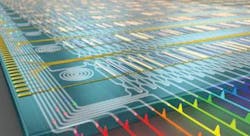New Dutch silicon nitride photonics company, QuiX, aims at quantum computing
Dutch scientists from the University of Twente and the research institute AMOLF (Amsterdam) have teamed up to create the first quantum photonic processor based on silicon nitride waveguides. Supported by pre-seed investor RAPH2INVEST, Ad Lagendijk, Willem Vos, Klaus Boller, Pepijn Pinkse, and Jelmer Renema have launched QuiX with the aim to create the a road to quantum computing that builds on their fundamental research.
QuiX B.V. aims to introduce the first single-purpose photonic quantum computer on the market for use in machine learning and quantum simulation applications. The technology is based on research that has, for example, resulted in a silicon nitride waveguide based reconfigurable 8x8 integrated linear optical network for quantum information processing.1 In two years, QuiX will make the first components of this computer available, in the form of a photonic processor with specifications aimed at far beyond the current state-of-the-art. Such a device could be of strong interest to the academic and commercial quantum computing communities.
For quantum computers, the main advantage of photonics over other quantum computing technologies is that processors operate at room temperature, whereas most other quantum computing platforms function just above 0 K, thereby requiring costly liquid-helium cryogenics. Jelmer Renema, the chief technical officer of QuiX, notes that the company's photonic integrated-circuit technology is based on the TripleX technology of integrated-optics giant LioniX International (Enschede, Netherlands). "Their ultralow-loss waveguide technology enables us to produce sufficiently large matrices to facilitate complex calculations and thereby outperform classical computers," says Renema.
REFERENCE:
1. Caterina Taballione et al., arXiv:1805.10999 (2018).

John Wallace | Senior Technical Editor (1998-2022)
John Wallace was with Laser Focus World for nearly 25 years, retiring in late June 2022. He obtained a bachelor's degree in mechanical engineering and physics at Rutgers University and a master's in optical engineering at the University of Rochester. Before becoming an editor, John worked as an engineer at RCA, Exxon, Eastman Kodak, and GCA Corporation.
